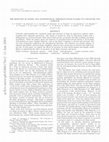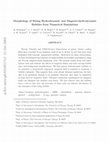Papers by Alejandro Caceres

Astrophysical Journal, 2003
Critically understanding the 'standard candle'-like behavior of Type Ia supernovae requires under... more Critically understanding the 'standard candle'-like behavior of Type Ia supernovae requires understanding their explosion mechanism. One family of models for Type Ia Supernovae begins with a deflagration in a Carbon-Oxygen white dwarf which greatly accelerates through wrinkling and flame instabilities. While the planar speed and behavior of astrophysically-relevant flames is increasingly well understood, more complex behavior, such as the flame's response to stretch and curvature, has not been extensively explored in the astrophysical literature; this behavior can greatly enhance or suppress instabilities and local flame-wrinkling, which in turn can increase or decrease the bulk burning rate. In this paper, we explore the effects of curvature on both nuclear flames and simpler model flames to understand the effect of curvature on the flame structure and speed.
Astrophysical Journal Supplement Series, 2002
We look in detail at the process of mapping an astrophysical initial model from a stellar evoluti... more We look in detail at the process of mapping an astrophysical initial model from a stellar evolution code onto the computational grid of an explicit, Godunov type code while maintaining hydrostatic equilibrium. This mapping process is common in astrophysical simulations, when it is necessary to follow short-timescale dynamics after a period of long timescale buildup. We look at the effects of spatial resolution, boundary conditions, the treatment of the gravitational source terms in the hydrodynamics solver, and the initialization process itself. We conclude with a summary detailing the mapping process that yields the lowest ambient velocities in the mapped model.

Recent Chandra and XMM-Newton observations of galaxy cluster cooling flows have revealed X-ray em... more Recent Chandra and XMM-Newton observations of galaxy cluster cooling flows have revealed X-ray emission voids of up to 30 kpc in size that have been identified with buoyant, magnetized bubbles. Motivated by these observations, we have investigated the behavior of rising bubbles in stratified atmospheres using the Flash adaptive-mesh simulation code. We present results from 2-D simulations with and without the effects of magnetic fields, and with varying bubble sizes and background stratifications. We find purely hydrodynamic bubbles to be unstable; a dynamically important magnetic field is required to maintain a bubble's integrity. This suggests that, even absent thermal conduction, for bubbles to be persistent enough to be regularly observed, they must be supported in large part by magnetic fields. Thermal conduction unmitigated by magnetic fields can dissipate the bubbles even faster. We also observe that the bubbles leave a tail as they rise; the structure of these tails can indicate the history of the dynamics of the rising bubble.

Astrophysical Journal, 2004
Recent Chandra and XMM-Newton observations of galaxy cluster cooling flows have revealed X-ray em... more Recent Chandra and XMM-Newton observations of galaxy cluster cooling flows have revealed X-ray emission voids of up to 30 kpc in size that have been identified with buoyant, magnetized bubbles. Motivated by these observations, we have investigated the behavior of rising bubbles in stratified atmospheres using the Flash adaptive-mesh simulation code. We present results from 2-D simulations with and without the effects of magnetic fields, and with varying bubble sizes and background stratifications. We find purely hydrodynamic bubbles to be unstable; a dynamically important magnetic field is required to maintain a bubble's integrity. This suggests that, even absent thermal conduction, for bubbles to be persistent enough to be regularly observed, they must be supported in large part by magnetic fields. Thermal conduction unmitigated by magnetic fields can dissipate the bubbles even faster. We also observe that the bubbles leave a tail as they rise; the structure of these tails can indicate the history of the dynamics of the rising bubble.
El riesgo de liquidez se entiende como la pérdida potencial provocada por la venta anticipada de ... more El riesgo de liquidez se entiende como la pérdida potencial provocada por la venta anticipada de activos financieros propiedad de los fondos administrados, a descuentos inusuales, para hacer frente a salidas de efectivo no programadas, o bien por el hecho de que una operación no pueda ser oportunamente liquidada o cubierta con el efectivo disponible. Una situación de este tipo se presenta cuando se enfrenta una necesidad de recursos por encima de los disponibles en forma líquida. Por tanto, se puede manifestar como un problema generalizado del mercado, de un instrumento en particular, o como presiones sobre el flujo de efectivo, originadas por el retiro de fondos, bajo cualquier circunstancia.
Uploads
Papers by Alejandro Caceres